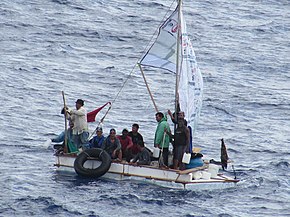Ferryman
The term rafters is used to refer to Cubans who try to reach the coasts of the United States, crossing the Straits of Florida in precarious boats, in search of better living conditions. Among the reasons that try to explain this situation, it is said more frequently that the rafters are fleeing the political conditions and economic difficulties that plague their country. The anti-Castroists attribute this situation to the mismanagement of the Cuban rulers and the socialist government system in force for five decades, and the immigration policies that the government maintains with the Cuban people, while the sympathizers of the Revolution attribute this situation to the embargo that the United States has imposed Cuba since 1960. This embargo (called the Cuban blockade) prevents economic transactions between Cuba and the United States, as well as with foreign companies controlled by Americans.
Fleeing Cuba by Cubans who do not agree with government policies is frequent, but another possible cause is perhaps the US policy regarding family visits and gifts to them by Cuban émigrés. The Political and Economic causes coexist in the Cuban who embarks on such a risky adventure with the same intensity unlike what happens with other Mexican emigration through the Rio Grande ("wet backs"), the Africans in southern European countries or Asians in Japan where economic forces are predominant. The question regarding the attitude of the US government is complex. In some cases they are returned to Cuba after being caught on its coasts, although in others they are welcomed. This is called the "wet foot" policy; (caught in the sea) and "dry feet" (they managed to reach the mainland). The rafters, in their eagerness to leave the island, arrive from countries like the Bahamas, Mexico and Honduras, among others from Central and South America, where they are often repatriated to Cuba. It is estimated that between 16,000 and 100,000 rafters perished at sea while fleeing Cuba.
Elian Gonzalez case
One of the best-known rafters was the boy Elián González, whose mother died on the journey with her son to Florida. This became a point of tension between the United States, where the child had been taken in by his paternal family, that is, by Elián's father's uncle, but without his parental consent, and Cuba, whose government demanded the delivery of the child to the father, resident on the island.
In Florida and Cuba, demonstrations took place every Saturday and holiday in "open stands" asking for what they considered "liberation" of the child. From various sources of political interest, donations of large sums of dollars were sent in favor of the family that had seized the child, which became an economic movement that caused them to be considered a case of corruption. By order of the attorney general from the United States, Janet Reno, a SWAT group carried out the rescue (extraction) of the boy from the house of his relatives in Miami, because they refused to hand him over. He was returned to the Cuban authorities, who handed him over to his father.
Other notorious cases
Possibly the most notorious and unique incident occurred in July 2003, when twelve Cubans using a 1951 Chevy truck tried to reach the Florida coast. The truck was kept afloat by a series of empty tanks and a small propeller attached to the truck's engine, which allowed it to reach approximately 8 MPH. The rafters-truckers were sighted about 40 miles south of Key West by the United States Coast Guard and returned to Cuba. The amphibious vehicle was sunk at sea to avoid being used as a monument to the inventiveness of those trying to leave Cuba, according to statements by the federal authorities themselves. Some time later they tried again but in a 1959 Buick.
Contenido relacionado
Spanish Constitution of 1978
President of the Generalitat of Catalonia
Town planning
